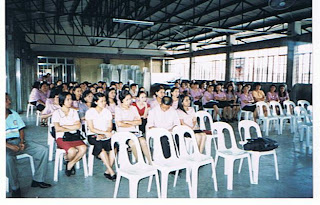When October ends, will the pink
carnival also end? Nope, because breast cancer will continue to dominate the fear of
every woman in the Philippines where 1 in 13 will get the disease. The show goes on.....
As aptly said by Rosa Francia Meneses during the 1999 World Conference on Breast Cancer in Ottawa, “The
greatest risk of getting breast cancer tomorrow is being born today in a
developing country. The greatest risk of not surviving breast cancer today is
being a woman in the Philippines."
In the Philippines, the
Department of Health has more than once embarked on major breast cancer programs
since 20 years ago. None has made any major inroad as seen by the country’s registering the highest growth in incidence rate worldwide while having the 12th
highest mortality rate. Only recently, the government’s Philippine Health Insurance Corporation opened the doors to more over-diagnosis and over-treatments of breast cancer by providing treatment funds for its qualified members.
And at the legislative levels of government, no bill has
been written for the prevention of this environmental disease. All bills proposed were on early detection thru mammography – clearly riding this public health issue
from a medical point of view and NOT on a people’s point of view, which is “we
do not want to get breast cancer!”
Media has even made
itself part of the carnival by featuring the latest treatments, even
alternative ones. All the 3 major television networks more than once took
contact with the PBCN for their respective features for breast cancer month.
However, the PBCN saw no reason to be part of the "carnival" - the
glamorization, commercialization and misinformation. Either they wanted
personalities with breast cancer to attract viewers, prop up the
medical-pharmaceutical industry or present early detection as a preventive
measure. It was best and prudent for the PBCN no to be used as a decor or
worse, to be misrepresented to the public. All were grossly lacking in research
and journalism depth. I challenged them to make a powerful feature on the risks
and dangers of annual chest x-rays and mammograms but I knew none would take me
upon it. So don't think that all the talk on breast cancer seen on television is
reliable - they will simply go through the motions with not much substance.
 So who will benefit with the
October breast cancer awareness month? The medical—pharmaceutical-supplement
network industry! Even a supposedly conscientious company has allowed itself to be used which would likewise benefit themselves. The entire awareness blah-blah-blah will simply scare women to seek medical solutions without addressing how they got it in the first place. And why would
it be important for every patient to understand her environmental exposures
which led to her breast cancer? Because her daughters, sisters, relatives,
neighbors and co-workers will one day also get breast cancer – not from the
genes but because of environmental risk exposures!
So who will benefit with the
October breast cancer awareness month? The medical—pharmaceutical-supplement
network industry! Even a supposedly conscientious company has allowed itself to be used which would likewise benefit themselves. The entire awareness blah-blah-blah will simply scare women to seek medical solutions without addressing how they got it in the first place. And why would
it be important for every patient to understand her environmental exposures
which led to her breast cancer? Because her daughters, sisters, relatives,
neighbors and co-workers will one day also get breast cancer – not from the
genes but because of environmental risk exposures!The PBCN has been observing several patients from specific areas but not limited to Angeles City (Pampanga), Guihulngan (Negros Oriental) and Bacoor (Cavite). What is similar to all is their ground water supply which is most definitely contaminated with carcinogens from different sources.
Then as far as occupational hazards would be the high incidence rate among government female workers – specifically public school teachers. The required annual chest x-rays have only done harm by exposing their breasts to repeated radiation particularly during their periods of vulnerability.
 There is no such thing as early detection. It takes 5 to 10 years before the first symptoms of breast cancer are manifested. So-called long term survivors either had no cancer in the very first place (over diagnosis) or had non-aggressive types such as DCIS (Ductal Carcinoma In Situ) which was never life-threatening even without treatment.
There is no such thing as early detection. It takes 5 to 10 years before the first symptoms of breast cancer are manifested. So-called long term survivors either had no cancer in the very first place (over diagnosis) or had non-aggressive types such as DCIS (Ductal Carcinoma In Situ) which was never life-threatening even without treatment.
Mammography is a medical risk
factor for eventually getting breast cancer. Women are being told year in and
year out that they are clear from the disease, only waiting for the time to be
told, “I’m sorry Ma’m but you now have breast cancer,”
 |
| The October carnival happens every year but the tragedy of breast cancer must stop. NO to mammography! |








